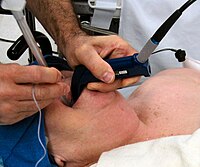
Photo from wikipedia
AIM To analyse the effect of endotracheal tube cuff pressure control measures on the microaspiration of the stomach contents by measuring at the level of pepsin in deep tracheal aspiration.… Click to show full abstract
AIM To analyse the effect of endotracheal tube cuff pressure control measures on the microaspiration of the stomach contents by measuring at the level of pepsin in deep tracheal aspiration. DESIGN A single-blind, randomised controlled trial. METHODS This trial protocol was reported using the SPIRIT checklist. Endotracheal tube cuff pressure control will be provided with pilot balloon finger palpation, intermittent and continuous. The pepsin level will be measured during deep tracheal secretions in order to assess the effect of different endotracheal tube cuff pressure control measures on the microaspiration of the stomach contents. The samples will be examined within the first 4 h, between the 5th and 24th hours, and between the 25th and 48th hours after intubation. The level of pepsin will be considered positive according to the cut-off value. In addition, the effect of different endotracheal tube cuff pressure controls on the incidence of ventilator-associated pneumonia will be examined. In study group 1, study group 2 and the control group, the number of patients is planned to be 56. TRIAL REGISTRATION ClinicalTrials.gov Identifier, Number NCT04061083. Registered in 2019. DISCUSSION The findings will show the effect of different endotracheal tube cuff pressure control methods on microaspiration of stomach content and the possible changes in pepsin level in deep tracheal aspirates. CONCLUSION This study will shed light on future studies regarding pepsin level as a biomarker in treatment and follow-up patients receiving mechanical ventilator support using an ETT and emphasise the importance of multidisciplinary studies. RELEVANCE TO CLINICAL PRACTICE As a result of the findings to be obtained from this study, the effect of endotracheal tube cuff pressure control on gastric content microaspiration and ventilator-associated pneumonia will be determined and the most appropriate endotracheal tube cuff pressure control method will be identified to prevent it. Nurses' awareness of endotracheal tube cuff pressure measurement methods will be increased. The frequency and methods of endotracheal tube cuff pressure control will provide strong evidence that can be included in the ventilator-associated pneumonia prevention care bundle.
Journal Title: Journal of clinical nursing
Year Published: 2022
Link to full text (if available)
Share on Social Media: Sign Up to like & get
recommendations!